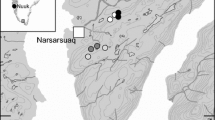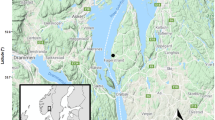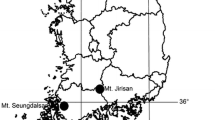Abstract
Understanding how assemblages of invertebrates change over continuous elevational gradients not only generates an understanding of current rules of community assembly but may also be useful for predicting the future distributions of species under global change. Temperature decreases predictably with increasing elevation and, accordingly, gradients in elevation permit the study of adjacent climates within small geographical areas. The present study examines if and how assemblages of moths change with increasing elevation in the eastern French Pyrenees. Elevation had a strong effect on the assemblage composition of moth species in both seasons. The species sets which contributed most to this strong pattern differed completely across seasons. Analysis of restrictions and fidelity to particular elevational ranges generated a set of indicator species which can be used to monitor future changes in distribution. Twelve species were identified as elevation-specific indicators (the ‘predictor set’) from the spring samples and summer samples. We note the strong contrasts between species that produce overall statistical pattern and those that show strong fidelity to particular elevations and discuss this in terms of the biologies of the species concerned. We discuss best practice for the identification and use of indicator species for monitoring future responses to climate change.



Similar content being viewed by others
Data availability
Data has been deposited at https://osf.io/w2tdz/.
References
Alonso-Rodríguez AM, Finegan B, Fiedler K (2017) Neotropical moth assemblages degrade due to oil palm expansion. Biodivers Conserv 26:1–32
Ashton LA, Kitching RL, Maunsell S, Bito D, Putland D (2011) Macrolepidopteran assemblages along an altitudinal gradient in subtropical rainforest: exploring indicators of climate change. Mem Queensl Mus 55:375–389
Ashton LA, Barlow HS, Nakamura A, Kitching RL (2014) Diversity in tropical ecosystems: the species richness and turnover of moths in Malaysian rainforests. Insect Conserv Diver 8:132–142
Ashton L, Nakamura A, Burwell C, Tang Y, Cao M, Whitaker T, Sun Z, Huang H, Kitching R (2016a) Elevational sensitivity in an Asian ‘hotspot’: moth diversity across elevational gradients in tropical, sub-tropical and sub-alpine China. Sci Rep 6:26513
Ashton L, Odell E, Burwell C, Maunsell S, Nakamura A, McDonald W, Kitching R (2016b) Altitudinal patterns of moth diversity in tropical and subtropical Australian rainforests. Austral Ecol 41:197–208
Axmacher JC, Fiedler K (2008) Habitat type modifies geometry of elevational diversity gradients in geometrid moths (Lepidoptera Geometridae) on Mt Kilimanjaro, Tanzania. Trop Zool 21:243–251
Bachelard P, Berard R, Colomb C, Demerges D, Doux Y, Fournier F, Gibeaux C, Maechier J, Robineau R, Schmit P, Tautet C (2011) Guide des papillons nocturnes de France Delachaux & Niestle, France
Beck J, Schulze CH, Linsenmair KE, Fiedler K (2002) From forest to farmland: diversity of geometrid moths along two habitat gradients on Borneo. J Trop Ecol 18:33–51
Beck J, Altermatt F, Hagmann R, Lang S (2010) Seasonality in the altitude-diversity pattern of Alpine moths. Basic Appl Ecol 11:714–722
Beck J, McCain CM, Axmacher JC, Ashton LA, Bärtschi F, Brehm G, Choi S-W, Cizek O, Colwell RK, Fiedler K, Francois CL, Highland S, Holloway JD, Intachat J, Kadlec T, Kitching RL, Maunsell SC, Merckx T, Nakamura A, Odell E, Sang W, Toko PS, Zamecnik J, Zou Y, Novotny V (2017) Elevational species richness gradients in a hyperdiverse insect taxon: a global meta-study on geometrid moths. Glob Ecol Biogeogr 26:412–424
Brehm G, Colwell RK, Kluge J (2007) The role of environment and mid-domain effect on moth species richness along a tropical elevational gradient. Glob Ecol Biogeogr 16:205–219
Brehm G, Hebert PD, Colwell RK, Adams M-O, Bodner F, Friedemann K, Möckel L, Fiedler K (2016) Turning up the heat on a hotspot: DNA barcodes reveal 80% more species of geometrid moths along an Andean elevational gradient. PLoS ONE 11:e0150327
Chen IC, Shiu H, Benedick S, Holloway JD, Chey VK, Barlow HS, Hill JK, Thomas CD (2009) Elevation increases in moth assemblages over 42 years on a tropical mountain. Proc Natl Acad Sci USA 106:1479–1483
Choi SW, An JS (2010) Altitudinal distribution of moths (Lepidoptera) in Mt. Jirisan National Park, South Korea. Eur J Entomol 107:229–245
Clarke K, Gorley R (2015) PRIMER-E, Plymouth
Colwell RK (2006) EstimateS: statistical estimation of species richness and shared species from simples, version 8.0. http://purl.oclc.org/estimates
Colwell RK, Gotelli NJ, Ashton LA, Beck J, Brehm G, Fayle TM, Fiedler K, Forister ML, Kessler M, Kitching RL, Klimes P, Kluge J, Longino JT, Maunsell SC, McCain CM, Moses J, Noben S, Sam K, Sam L, Shapiro AM, Wang X, Novotny V (2016) Midpoint attractors and species richness: Modelling the interaction between environmental drivers and geometric constraints. Ecol Lett 19:1009–1022
Common IFB (1990) Moths of Australia. Melbourne University Press, Melbourne
Dendaletche C (1997) Les Pyrénées: la vie sauvage en montagne et celle des hommes. Delachaux et Niéstle, Paris
Didham RK, Fagan LL (2003) Project IBISCA—investigating the biodiversity of soil and canopy arthropods. Weta 26:1–6
Dufrene M, Legendre P (1997) Species assemblages and indicator species: the need for a flexible asymmetrical approach. Ecol Monogr 67:345–366
Dupias G (1985) Vegetation des pyrenees. Centre National De La Recherche Scientifique, Paris
Fiedler K, Hilt N, Brehm G, Schulze CH (2007) Moths at tropical forest margins—how mega-diverse insect assemblages respond to forest disturbance and recovery. In: Tscharntke T, Leuschner C, Zeller M, Guhardja E, Bidin A (eds) Stability of tropical rainforest margins, linking ecological, economic and social constraints of land use and conservation. Springer, Berlin, pp 37–58
Gaston KJ (2010) Valuing common species. Science 327:154–155
Hausmann A (2004) The geometrid moths of Europe 2: Sterrhinae. Apollo, Steenstrup
Hausmann A, Viidalepp J (2012) The geometrid moths of Europe 3: subfamily Larentiinae 1. Apollo, Steenstrup
Highland SA, Miller JC, Jones JA (2013) Determinants of moth diversity and community in a temperate mountain landscape: vegetation, topography, and seasonality. Ecosphere 4:1–22
Hodkinson ID (2005) Terrestrial insects along elevation gradients: species and community responses to altitude. Biol Rev 80:489–513
Jaroš J, Spitzer K, Zikmundová H (2014) Variability of Lepidoptera communities (moths and butterflies) along an altitudinal gradient of peat bogs from the Třeboň Basin up to the Bohemian Forest (South Bohemia, Central Europe). Silva Gabreta 20:55–95
Ji Y, Ashton L, Pedley SM, Edwards DP, Tang Y, Nakamura A, Kitching R, Dolman PM, Woodcock P, Edwards FA, Larsen TH, Hsu WW, Benedick S, Hamer KC, Wilcove DS, Bruce C, Wang X, Levi T, Lott M, Emerson BC, Yu DW (2013) Reliable, verifiable and efficient monitoring of biodiversity via metabarcoding. Ecol Lett 16:1245–1257
Kaltsas D, Dede K, Giannaka J, Nasapoulou T, Kechaglioglou S, Grigoriadou E, Raptis D, Damos P, Vasiliadis I, Christopolous V, Loukaki E, Franses R, Vlachaki D, Avtzis DN (2018) Taxonomic and functional diversity of butterflies along an altitudinal gradient in two NATURA 2000 sites in Greece. Insect Conserv Diver 11:464–478
Kitching R (2011) Lepidoptera in Vanuatu: fauna, geography and the IBISCA-Santo project. In: Bouchet P, Guyader HL, Pascal O (eds) The natural history of Santo. Museum National d’Historie naturelle, Paris, pp 155–160
Kitching RL, Orr AG, Thalib L, Mitchell H, Hopkins MS, Graham AW (2000) Moth assemblages as indicators of environmental quality in remnants of upland Australian rain forest. J Appl Ecol 37:284–297
Kitching RL, Boulter SL, Vickerman G, Laidlaw M, Hurley KL, Grimbacher PS (2005) The comparative assessment of arthropod and tree biodiversity in old-world rainforests, 2nd edn. Rainforest CRC & Earthwatch Institute, James Cook University, Cairns
Kitching RL, Putland D, Ashton LA, Laidlaw MJ, Boulter SL, Christensen H, Lambkin CL (2011) Detecting biodiversity changes along climatic gradients: the IBISCA Queensland Project. Mem Queensl Mus 55:235–250
Kitching RL, Ashton LA, Nakamura A, Whitaker T, Chey CV (2013) Distance-driven species turnover in Bornean rainforests: homogeneity and heterogeneity in primary and post-logging forests. Ecography 36:675–682
Kitching R, Nakamura A, Yasuda M, Hughes A, Min C (2015) Environmental determinism of community structure across trophic levels: moth assemblages and substrate type in the rain forests of south-western China. J Trop Ecol 31:81–89
Leguédois S, Party J-P, Dupouey J-L, Gauquelin T, Gégout J-C, Lecareux C, Badeau V, Rizetto S, Probst A (2014) The vegetation map of France going numerical: a new harmonised national geographical database
Leraut P (2014) Moths of Europe, vol. 4: pyralids 2. NAP editions, Paris
Majerus M (2002) Moths. New naturalist series. HarperCollins, London
Merckx T (2015) Rewilding: pitfalls and opportunities for moths and butterflies, rewilding European landscapes. Springer, Cham, pp 107–125
Merckx T, Slade EM (2014) Macro-moth families differ in their attraction to light: implications for light-trap monitoring programmes. Insect Conserv Diver 7:453–461
Nöske NM, Hilt N, Werner FA, Brehm G, Fiedler K, Sipman HJM, Gradstein SR (2008) Disturbance effects on diversity of epiphytes and moths in a montane forest in Ecuador. Basic Appl Ecol 9:4–12
Novotny V, Basset Y, Miller SE, Weiblen GD, Bremer B, Cizek L, Drozd P (2002) Low host specificity of herbivorous insects in a tropical forest. Nature 416:841–844
Odell EH, Ashton LA, Kitching RL (2016) Elevation and moths in a central eastern Queensland rainforest. Austral Ecol 41:133–144
Oksanen J, Kindt R, Legendre P, O’Hara B, Simpson GL, Henry M, Stevens H (2016) Vegan: community ecology package R Package version 2.3-2. https://cran.r-project.org/web/packages/vegan
Razowski J (2002) Tortricidae (Lepidoptera) of Europe. Tortricinae and Chlidanotinae, vol 1. Frantisek Slamka, Bratislava
Razowski J (2003) Tortricidae (Lepidoptera) of Europe. Olethreutinae, vol 2. Franisek Slamka, Bratislava
Roberts D (2007) Labdsv: ordination and multivariate analysis for ecology. R package version 1, 3-1
Sabatini FM, Keeton WS, Levers C, Lindner M, Pötzschner F, Verkerk PJ, Bauhus J, Buchwald E, Chaskovsky O, Debaive N, Horváth F, Garbarino M, Grigoriadis N, Lombardi F, Duarte IM, Meyer P, Midteng R, Mikac S, Mikolás M, Motta R, Mozgeris M, Nunes L, Panayotov M, Odor P, Ruete A, Simovski B, Stillhard I, Svoboda M, Szwagrzyk J, Tikkanen O-P, Volosyanchuk R, Vrska T, Zlatanov T, Kuemmerle T (2018) Where are Europe’s last primary forests. Divers Distrib 24:1426–1439
Scoble MJ (1992) The Lepidoptera: form, function, and diversity. Oxford University Press, Oxford
Skinner B (1998) Colour identification guide to moths of the British Isles (Macrolepidoptera), 2nd edn. Viking, London
Skou P, Sihvonen P (2015) The geometrid moths of Europe 5: subfamily Ennominae 1. Brill, Leiden
Slamka F (2006) Pyraloidea of Europe: Pyralinae, Galleriinae, Epipaschiinae, Cathariinae & Odontiinae, Privately published, Bratislava
Slamka F (2008) Pyraloidea of Europe: Crambidae & Schoenobinae, Privately published, Bratislava
Slamka F (2013) Pyraloidea of Europe: Pyraustinae & Spilomelinae, Privately published, Bratislava
Truxa C, Fiedler K (2016) Massive structural redundancies in species composition patterns of floodplain forest moths. Ecography 39:253–260
Van Rensburg BJ, McGeoch MA, Chown SL, Van Jaarsveld AS (1999) Conservation of heterogeneity among dung beetles in the Maputaland Centre of Endemism, South Africa. Biol Conserv 88:145–153
Wang Y, Naumann U, Wright S, Warton D (2012a) mvabund: statistical methods for analysing multivariate abundance data. R package version 2.3-1.1
Wang Y, Neuman U, Wright S, Warton DI (2012b) Mvabund: an R package for model-based analysis of multivariate abundance data. Methods Ecol Evol 3:471–473
Warton DI, Wright ST, Wang Y (2012) Distance-based multivariate analyses confound location and dispersion effects. Methods Ecol Evol 3:89–101
Yela JL, Holyoak M (1997) Effects of moonlight and meteorological factors on light and bait trap catches of noctuid moths (Lepidoptera: Noctuidae). Environ Entomol 26:1283–1290
Acknowledgements
We thank the Research and Exploration Committee of the National Geographic Society for providing financial support for this project (Grant 9724-15). EJD was funded by the Griffith University School of Environment and Environmental Futures Research Institute. CT was supported by the ‘Laboratoire d’Excellence’ TULIP (ANR-10-LABX-41; ANR-11-IDEX-0002-02). LAA was supported by the UK NERC-funded Biodiversity And Land-use Impacts on Tropical Ecosystem Function (BALI) consortium (http://bali.hmtf.info) (NERC Grant No. NE/L000016/1). We thank also Drs Beverley Kitching and John Shillcock for their invaluable help as volunteers in the field. Thank you to the reviewers for making improvements this manuscript.
Author information
Authors and Affiliations
Corresponding author
Additional information
Publisher's Note
Springer Nature remains neutral with regard to jurisdictional claims in published maps and institutional affiliations.
Handling Editor: Nigel E. Stork.
Rights and permissions
About this article
Cite this article
Dale, E.J., Kitching, R.L., Thebaud, C. et al. Moths in the Pyrénées: spatio-temporal patterns and indicators of elevational assemblages. Biodivers Conserv 28, 1593–1610 (2019). https://doi.org/10.1007/s10531-019-01745-4
Received:
Revised:
Accepted:
Published:
Issue Date:
DOI: https://doi.org/10.1007/s10531-019-01745-4




